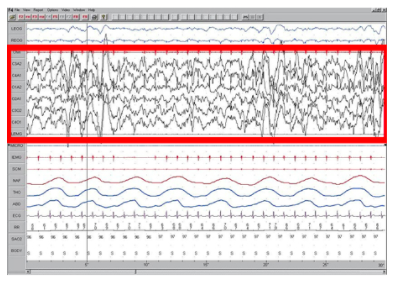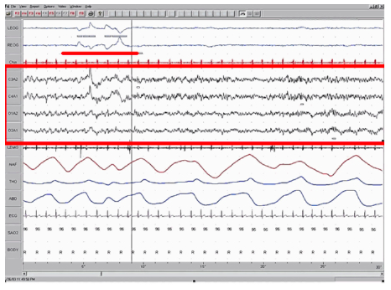Stages of Sleep
Sleep is not a uniform state of being. Instead, sleep is composed of several different stages that can be differentiated from one another by the patterns of brain wave activity that occur during each stage. These changes in brain wave activity can be visualized using an electroencephalogram (EEG) and are distinguished from one another by both the frequency and amplitude of brain waves. Sleep can be divided into two different general phases: REM sleep and non-REM (NREM) sleep. An electroencephalograph (EEG) measures electrical potentials across the surface of the scalp which are the result of neural activity within the brain.
REM sleep and non-REM (NREM) sleep
Rapid eye movement (REM) sleep is characterized by darting movements of the eyes under closed eyelids. Brain waves during REM sleep appear very similar to brain waves during wakefulness.
In contrast, non-REM (NREM) sleep is subdivided into three stages distinguished from each other and from wakefulness by characteristic patterns of brain waves.
The first three stages of sleep are NREM sleep, while the fourth and final stage of sleep is REM sleep.
NREM Sleep
Stage 1 sleep
Stage 1 sleep is a transitional phase that occurs between wakefulness and sleep. This corresponds to the period during which we drift off to sleep. During this time, respiration and heart rates slow. In addition, stage 1 sleep involves a marked decrease in both overall muscle tension and core body temperature.
In terms of brain wave activity, stage 1 sleep is associated with both alpha and theta waves. The early portion of stage 1 sleep produces alpha waves, which are relatively low frequency (8–13Hz), high amplitude patterns of electrical activity (waves) that become synchronized. This pattern of brain wave activity resembles that of someone who is very relaxed, yet awake. As an individual continues through stage 1 sleep there is an increase in theta wave activity. Theta waves have an even lower frequency (4–7 Hz) and higher amplitude than alpha waves.
It is relatively easy to wake someone from stage 1 sleep. In fact, if people are awoken during stage 1 sleep, they often report that they have not been asleep at all.

Stage 2 sleep
As we move into stage 2 sleep, the body goes into a state of deep relaxation. Theta waves still dominate the activity of the brain, but they are interrupted by brief bursts of activity known as sleep spindles (Figure 3). A sleep spindle is a rapid burst of higher frequency brain waves that may be important for learning and memory (Fogel & Smith, 2011; Poe, Walsh, & Bjorness, 2010). In addition, the appearance of K-complexes is often associated with stage 2 sleep. A K-complex is a very high amplitude pattern of brain activity that may in some cases occur in response to environmental stimuli. Thus, K-complexes might serve as a bridge to higher levels of arousal in response to what is going on in our environments (Halász, 1993; Steriade & Amzica, 1998).

Stage 3 sleep

REM Sleep
REM sleep
REM sleep is marked by rapid movements of the eyes. The brain waves associated with this stage of sleep are very similar to those observed when a person is awake, as shown in Figure 5, and this is the period of sleep in which dreaming occurs. It is also associated with paralysis of muscle systems in the body with the exception of those that make circulation and respiration possible. Therefore, no movement of voluntary muscles occurs during REM sleep in a normal individual. REM sleep is often referred to as paradoxical sleep because of this combination of high brain activity and muscular paralysis. Like NREM sleep, REM has been implicated in various aspects of learning and memory (Wagner, Gais, & Born, 2001), although there is disagreement within the scientific community about how important both NREM and REM sleep are for normal learning and memory (Siegel, 2001).

If people are deprived of REM sleep and then allowed to sleep without disturbance, they will spend more time in REM sleep in what appears to be an effort to recoup the lost time in REM. This is known as the REM rebound, and it suggests that REM sleep is also homeostatically regulated.
Aside from the role that REM sleep may play in processes related to learning and memory, REM sleep may also be involved in emotional processing and regulation. In such instances, REM rebound may actually represent an adaptive response to stress in nondepressed individuals by suppressing the emotional salience of stressful events that happened during the day (Suchecki, Tiba, & Machado, 2012). Though sleep deprivation in general is associated with a number of negative consequences (Brown, 2012), there is a correlation between more REM sleep and psychiatric disorders, particularly depression. In fact, antidepressents often disrupt REM sleep and some studies show that REM sleep deprivation can improve symptoms of depression.[1]

- Crișan, C. A., Milhem, Z., Stretea, R., Țața, I., Cherecheș, R. M., & Micluția, I. V. (2023). A Narrative Review on REM Sleep Deprivation: A Promising Non-Pharmaceutical Alternative for Treating Endogenous Depression. Journal of Personalized Medicine, 13(2), 306. https://doi.org/10.3390/jpm13020306 ↵